Abstract
Learning is widely thought to result from altered potency of synapses within the neural pathways that mediate the learned behavior. Support for this belief, which pervades current physiological and computational thinking, comes especially from the analysis of cases of simple learning in invertebrates. Here, evidence is presented that in one such case, habituation of crayfish escape, the learning is more due to onset of tonic descending inhibition than to the intrinsic depression of circuit synapses to which it was previously attributed. Thus, the altered performance seems to depend at least as much on events in higher centers as on local plasticity.
Full text
PDF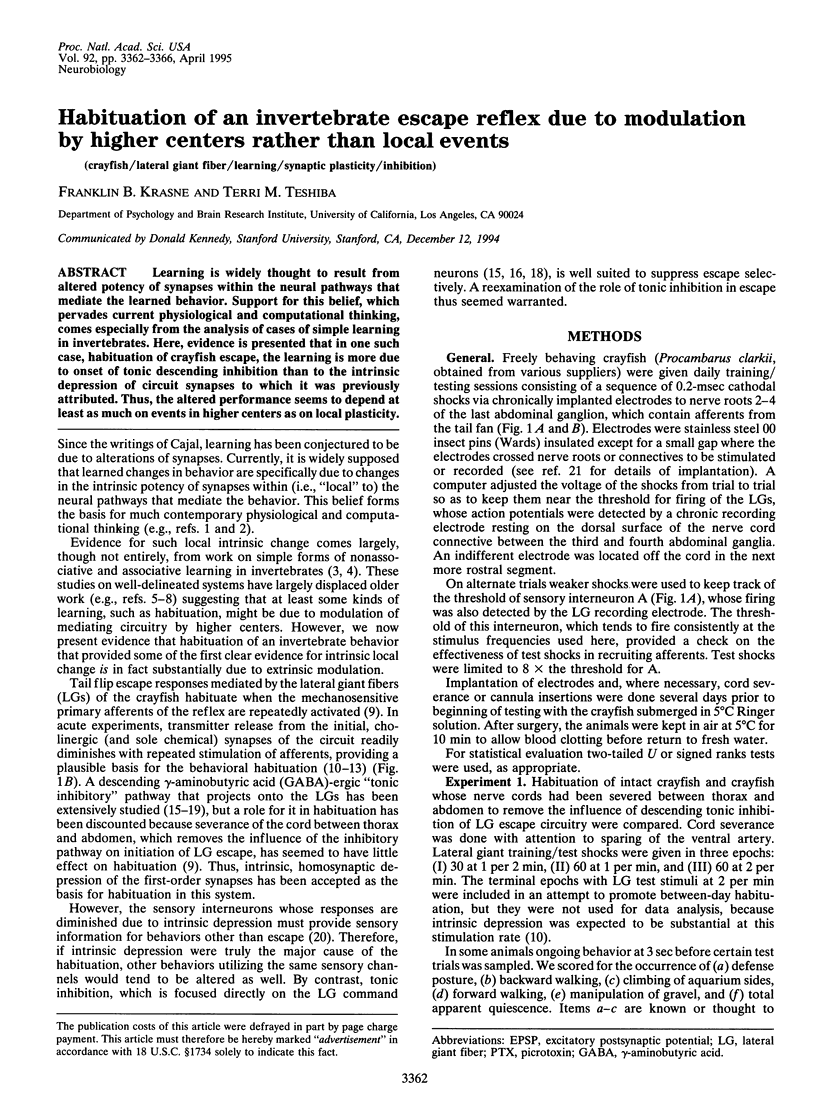
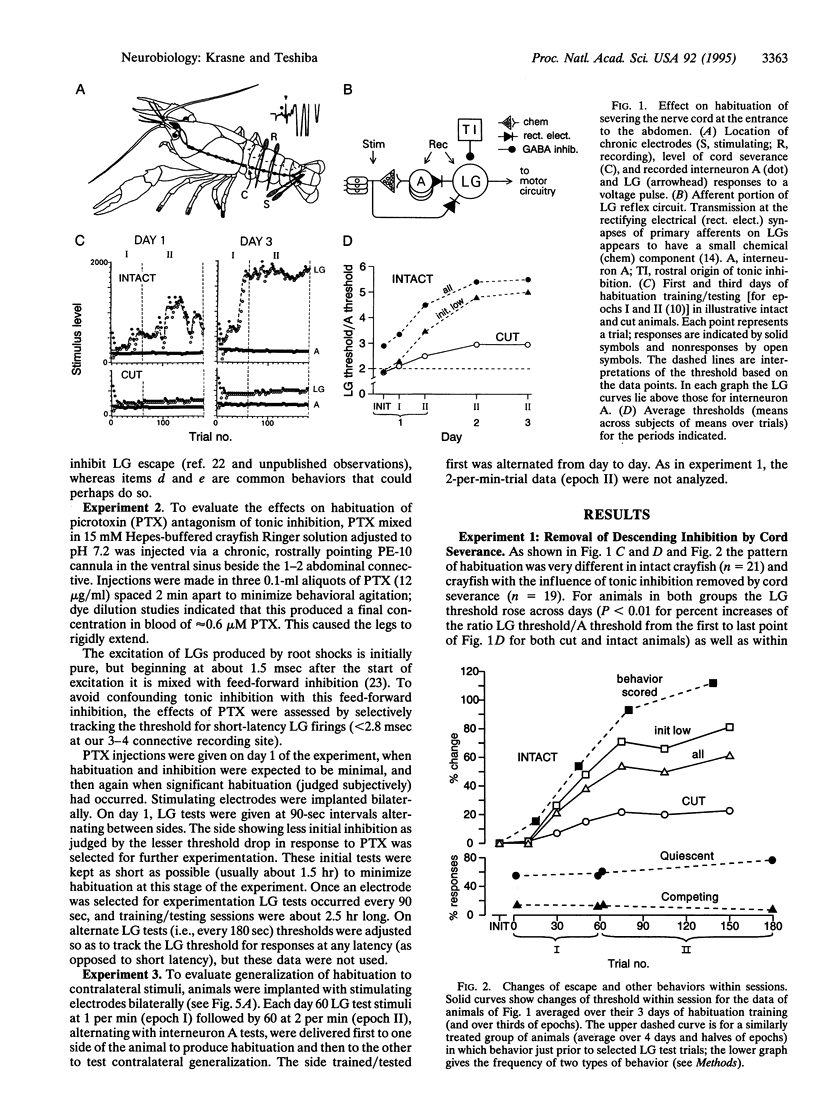
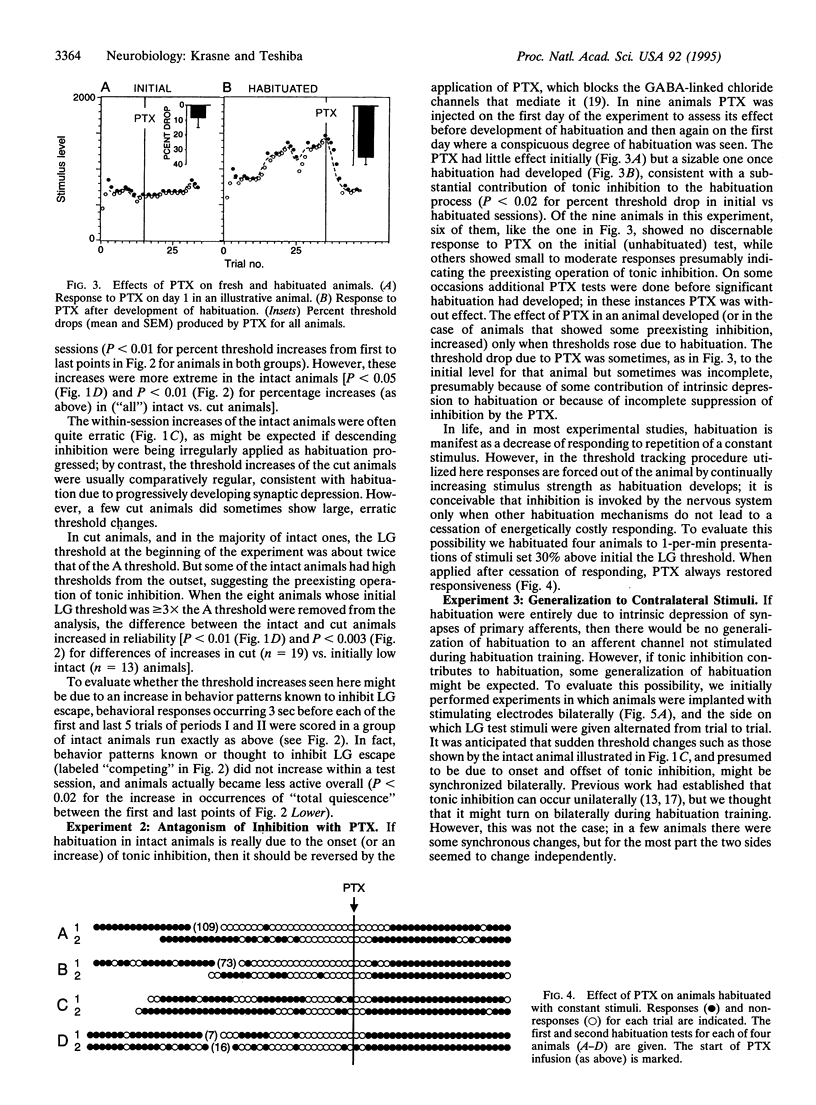
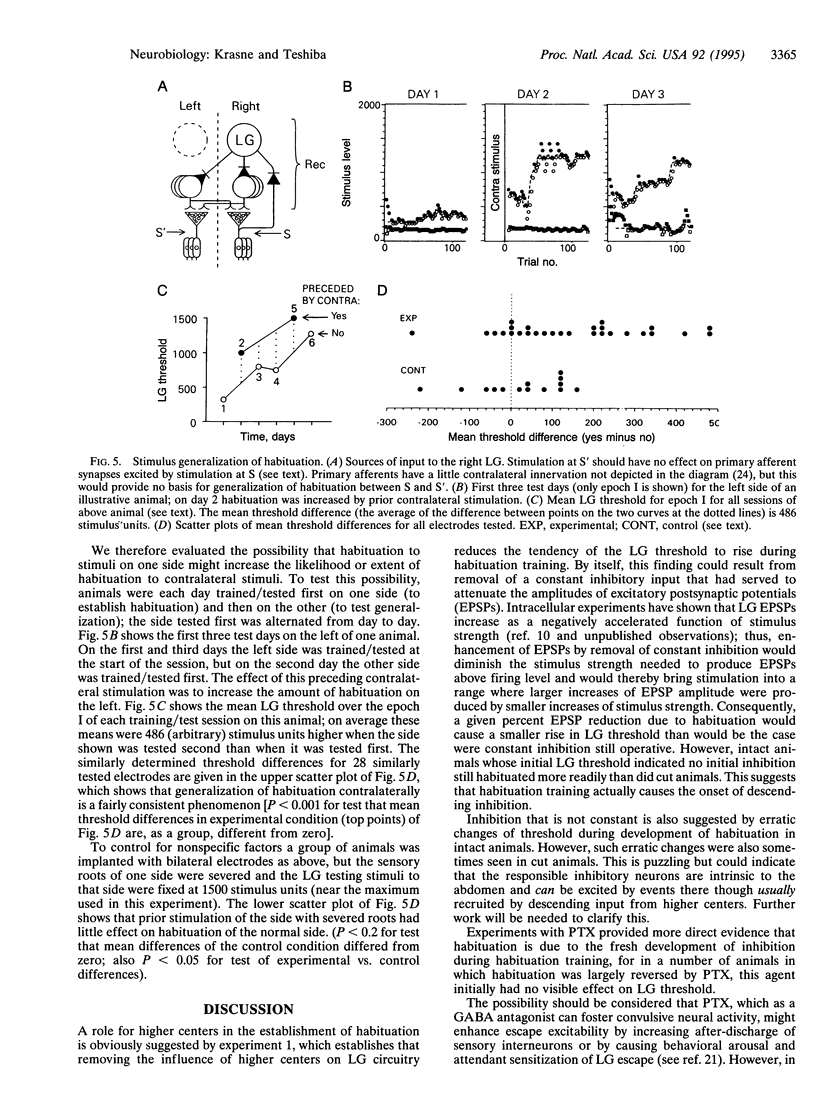
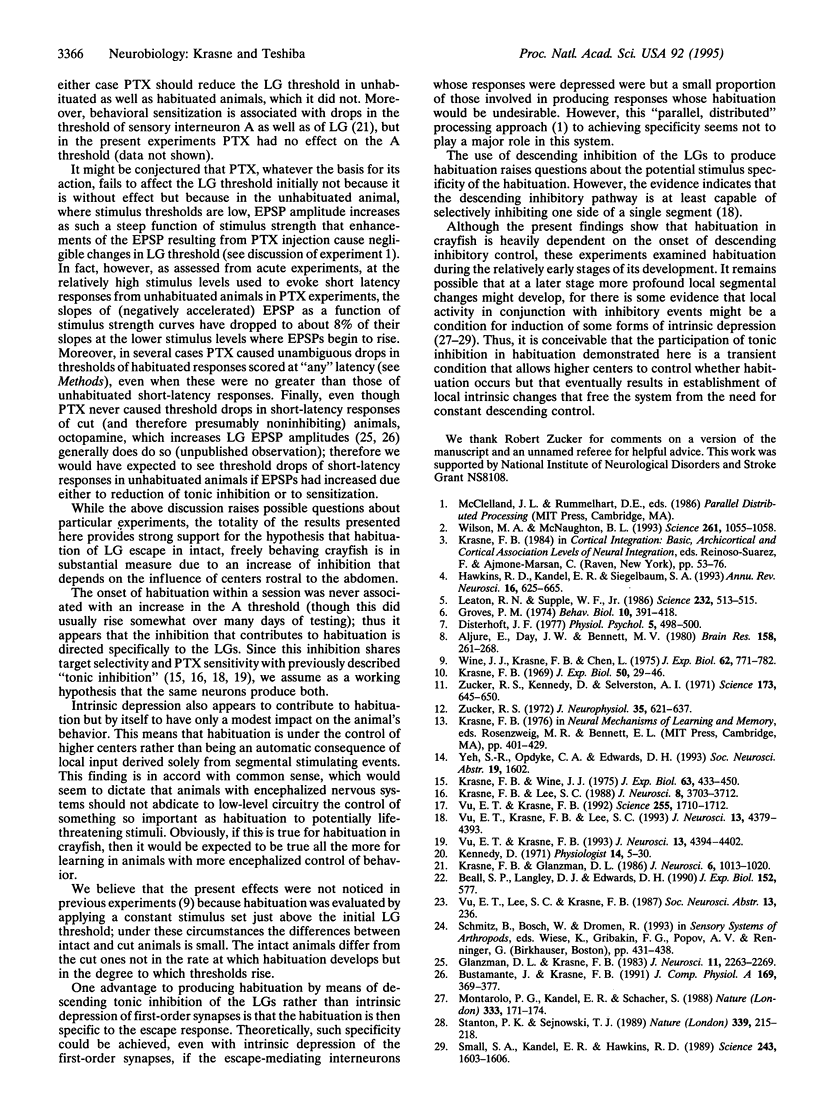
Selected References
These references are in PubMed. This may not be the complete list of references from this article.
- Aljure E., Day J. W., Bennett M. V. Postsynaptic depression of Mauthner cell-mediated startle reflex, a possible contributor to habituation. Brain Res. 1980 Apr 21;188(1):261–268. doi: 10.1016/0006-8993(80)90574-0. [DOI] [PubMed] [Google Scholar]
- Glanzman D. L., Krasne F. B. Serotonin and octopamine have opposite modulatory effects on the crayfish's lateral giant escape reaction. J Neurosci. 1983 Nov;3(11):2263–2269. doi: 10.1523/JNEUROSCI.03-11-02263.1983. [DOI] [PMC free article] [PubMed] [Google Scholar]
- Groves P. M., Wilson C. J., Boyle R. D. Brain stem pathways, cortical modulation, and habituation of the acoustic startle response. Behav Biol. 1974 Apr;10(4):391–418. doi: 10.1016/s0091-6773(74)91975-0. [DOI] [PubMed] [Google Scholar]
- Hawkins R. D., Kandel E. R., Siegelbaum S. A. Learning to modulate transmitter release: themes and variations in synaptic plasticity. Annu Rev Neurosci. 1993;16:625–665. doi: 10.1146/annurev.ne.16.030193.003205. [DOI] [PubMed] [Google Scholar]
- Kennedy D. Crayfish interneurons. Physiologist. 1971 Feb;14(1):5–30. [PubMed] [Google Scholar]
- Krasne F. B., Glanzman D. L. Sensitization of the crayfish lateral giant escape reaction. J Neurosci. 1986 Apr;6(4):1013–1020. doi: 10.1523/JNEUROSCI.06-04-01013.1986. [DOI] [PMC free article] [PubMed] [Google Scholar]
- Krasne F. B., Lee S. C. Response-dedicated trigger neurons as control points for behavioral actions: selective inhibition of lateral giant command neurons during feeding in crayfish. J Neurosci. 1988 Oct;8(10):3703–3712. doi: 10.1523/JNEUROSCI.08-10-03703.1988. [DOI] [PMC free article] [PubMed] [Google Scholar]
- Krasne F. B., Wine J. J. Extrinsic modulation of crayfish escape behaviour. J Exp Biol. 1975 Oct;63(2):433–450. doi: 10.1242/jeb.63.2.433. [DOI] [PubMed] [Google Scholar]
- Leaton R. N., Supple W. F., Jr Cerebellar vermis: essential for long-term habituation of the acoustic startle response. Science. 1986 Apr 25;232(4749):513–515. doi: 10.1126/science.3961494. [DOI] [PubMed] [Google Scholar]
- Montarolo P. G., Kandel E. R., Schacher S. Long-term heterosynaptic inhibition in Aplysia. Nature. 1988 May 12;333(6169):171–174. doi: 10.1038/333171a0. [DOI] [PubMed] [Google Scholar]
- Small S. A., Kandel E. R., Hawkins R. D. Activity-dependent enhancement of presynaptic inhibition in Aplysia sensory neurons. Science. 1989 Mar 24;243(4898):1603–1606. doi: 10.1126/science.2538924. [DOI] [PubMed] [Google Scholar]
- Stanton P. K., Sejnowski T. J. Associative long-term depression in the hippocampus induced by hebbian covariance. Nature. 1989 May 18;339(6221):215–218. doi: 10.1038/339215a0. [DOI] [PubMed] [Google Scholar]
- Vu E. T., Krasne F. B. Crayfish tonic inhibition: prolonged modulation of behavioral excitability by classical GABAergic inhibition. J Neurosci. 1993 Oct;13(10):4394–4402. doi: 10.1523/JNEUROSCI.13-10-04394.1993. [DOI] [PMC free article] [PubMed] [Google Scholar]
- Vu E. T., Krasne F. B. Evidence for a computational distinction between proximal and distal neuronal inhibition. Science. 1992 Mar 27;255(5052):1710–1712. doi: 10.1126/science.1553559. [DOI] [PubMed] [Google Scholar]
- Vu E. T., Lee S. C., Krasne F. B. The mechanism of tonic inhibition of crayfish escape behavior: distal inhibition and its functional significance. J Neurosci. 1993 Oct;13(10):4379–4393. doi: 10.1523/JNEUROSCI.13-10-04379.1993. [DOI] [PMC free article] [PubMed] [Google Scholar]
- Wilson M. A., McNaughton B. L. Dynamics of the hippocampal ensemble code for space. Science. 1993 Aug 20;261(5124):1055–1058. doi: 10.1126/science.8351520. [DOI] [PubMed] [Google Scholar]
- Zucker R. S. Crayfish escape behavior and central synapses. II. Physiological mechanisms underlying behavioral habituation. J Neurophysiol. 1972 Sep;35(5):621–637. doi: 10.1152/jn.1972.35.5.621. [DOI] [PubMed] [Google Scholar]
- Zucker R. S., Kennedy D., Selverston A. I. Neuronal circuit mediating escape responses in crayfish. Science. 1971 Aug 13;173(3997):645–650. doi: 10.1126/science.173.3997.645. [DOI] [PubMed] [Google Scholar]


